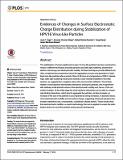Por favor, use este identificador para citar o enlazar a este item:
http://hdl.handle.net/10261/151257COMPARTIR / EXPORTAR:
 SHARE SHARE
 CORE
BASE CORE
BASE
|
|
| Visualizar otros formatos: MARC | Dublin Core | RDF | ORE | MODS | METS | DIDL | DATACITE | |

| Título: | Evidences of changes in surface electrostatic charge distribution during stabilization of HPV16 virus-like particles |
Autor: | Vega, Juan Francisco CSIC ORCID; Vicente-Alique, Ernesto CSIC; Núñez-Ramírez, Rafael CSIC ; Wang, Y.; Martínez-Salazar, Javier CSIC ORCID | Fecha de publicación: | 17-feb-2016 | Editor: | Public Library of Science | Citación: | PLoS ONE 11(2): 0149009 (2016) | Resumen: | The stabilization of human papillomavirus type 16 virus-like particles has been examined by means of different techniques including dynamic and static light scattering, transmission electron microscopy and electrophoretic mobility. All these techniques provide different and often complementary perspectives about the aggregation process and generation of stabilized virus-like particles after a period of time of 48 hours at a temperature of 298 K. Interestingly, static light scattering results point towards a clear colloidal instability in the initial systems, as suggested by a negative value of the second virial coefficient. This is likely related to small repulsive electrostatic interactions among the particles, and in agreement with relatively small absolute values of the electrophoretic mobility and, hence, of the net surface charges. At this initial stage the small repulsive interactions are not able to compensate binding interactions, which tend to aggregate the particles. As time proceeds, an increase of the size of the particles is accompanied by strong increases, in absolute values, of the electrophoretic mobility and net surface charge, suggesting enhanced repulsive electrostatic interactions and, consequently, a stabilized colloidal system. These results show that electrophoretic mobility is a useful methodology that can be applied to screen the stabilization factors for virus-like particles during vaccine development. | Descripción: | 17 págs.; 6 figs. ; Open Access funded by Creative Commons Atribution Licence 4.0 | Versión del editor: | https://doi.org/10.1371/journal.pone.0149009 | URI: | http://hdl.handle.net/10261/151257 | DOI: | 10.1371/journal.pone.0149009 | Identificadores: | doi: 10.1371/journal.pone.0149009 issn: 1932-6203 |
| Aparece en las colecciones: | (CFMAC-IEM) Artículos |
Ficheros en este ítem:
| Fichero | Descripción | Tamaño | Formato | |
|---|---|---|---|---|
| Evidences.pdf | 1,49 MB | Adobe PDF |  Visualizar/Abrir |
CORE Recommender
PubMed Central
Citations
1
checked on 24-abr-2024
SCOPUSTM
Citations
5
checked on 20-abr-2024
WEB OF SCIENCETM
Citations
5
checked on 27-feb-2024
Page view(s)
305
checked on 23-abr-2024
Download(s)
341
checked on 23-abr-2024

